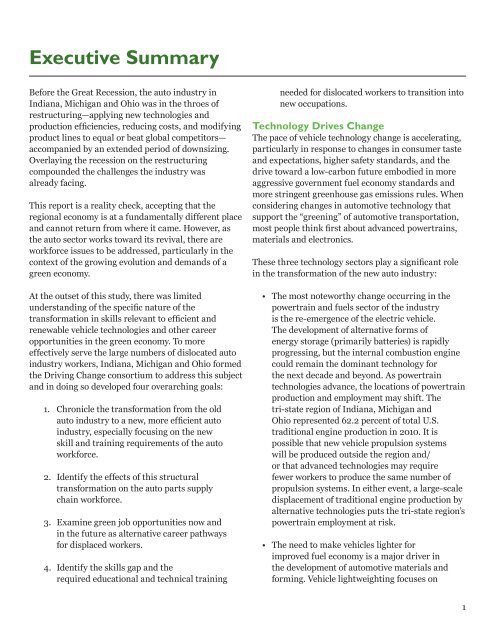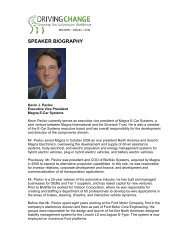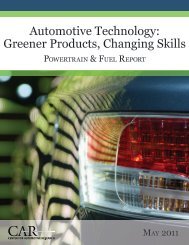Executive Summary - Driving Change: Greening the Automotive ...
Executive Summary - Driving Change: Greening the Automotive ...
Executive Summary - Driving Change: Greening the Automotive ...
- No tags were found...
Create successful ePaper yourself
Turn your PDF publications into a flip-book with our unique Google optimized e-Paper software.
<strong>Executive</strong> <strong>Summary</strong>Before <strong>the</strong> Great Recession, <strong>the</strong> auto industry inIndiana, Michigan and Ohio was in <strong>the</strong> throes ofrestructuring—applying new technologies andproduction efficiencies, reducing costs, and modifyingproduct lines to equal or beat global competitors—accompanied by an extended period of downsizing.Overlaying <strong>the</strong> recession on <strong>the</strong> restructuringcompounded <strong>the</strong> challenges <strong>the</strong> industry wasalready facing.This report is a reality check, accepting that <strong>the</strong>regional economy is at a fundamentally different placeand cannot return from where it came. However, as<strong>the</strong> auto sector works toward its revival, <strong>the</strong>re areworkforce issues to be addressed, particularly in <strong>the</strong>context of <strong>the</strong> growing evolution and demands of agreen economy.At <strong>the</strong> outset of this study, <strong>the</strong>re was limitedunderstanding of <strong>the</strong> specific nature of <strong>the</strong>transformation in skills relevant to efficient andrenewable vehicle technologies and o<strong>the</strong>r careeropportunities in <strong>the</strong> green economy. To moreeffectively serve <strong>the</strong> large numbers of dislocated autoindustry workers, Indiana, Michigan and Ohio formed<strong>the</strong> <strong>Driving</strong> <strong>Change</strong> consortium to address this subjectand in doing so developed four overarching goals:1. Chronicle <strong>the</strong> transformation from <strong>the</strong> oldauto industry to a new, more efficient autoindustry, especially focusing on <strong>the</strong> newskill and training requirements of <strong>the</strong> autoworkforce.2. Identify <strong>the</strong> effects of this structuraltransformation on <strong>the</strong> auto parts supplychain workforce.3. Examine green job opportunities now andin <strong>the</strong> future as alternative career pathwaysfor displaced workers.4. Identify <strong>the</strong> skills gap and <strong>the</strong>required educational and technical trainingneeded for dislocated workers to transition intonew occupations.Technology Drives <strong>Change</strong>The pace of vehicle technology change is accelerating,particularly in response to changes in consumer tasteand expectations, higher safety standards, and <strong>the</strong>drive toward a low-carbon future embodied in moreaggressive government fuel economy standards andmore stringent greenhouse gas emissions rules. Whenconsidering changes in automotive technology thatsupport <strong>the</strong> “greening” of automotive transportation,most people think first about advanced powertrains,materials and electronics.These three technology sectors play a significant rolein <strong>the</strong> transformation of <strong>the</strong> new auto industry:• The most noteworthy change occurring in <strong>the</strong>powertrain and fuels sector of <strong>the</strong> industryis <strong>the</strong> re-emergence of <strong>the</strong> electric vehicle.The development of alternative forms ofenergy storage (primarily batteries) is rapidlyprogressing, but <strong>the</strong> internal combustion enginecould remain <strong>the</strong> dominant technology for<strong>the</strong> next decade and beyond. As powertraintechnologies advance, <strong>the</strong> locations of powertrainproduction and employment may shift. Thetri-state region of Indiana, Michigan andOhio represented 62.2 percent of total U.S.traditional engine production in 2010. It ispossible that new vehicle propulsion systemswill be produced outside <strong>the</strong> region and/or that advanced technologies may requirefewer workers to produce <strong>the</strong> same number ofpropulsion systems. In ei<strong>the</strong>r event, a large-scaledisplacement of traditional engine production byalternative technologies puts <strong>the</strong> tri-state region’spowertrain employment at risk.• The need to make vehicles lighter forimproved fuel economy is a major driver in<strong>the</strong> development of automotive materials andforming. Vehicle lightweighting focuses on1
finding <strong>the</strong> optimal combination of materialsto achieve <strong>the</strong> desired vehicle weight reduction.Currently, <strong>the</strong> adoption of new materials isimpeded by risks of performance issues and<strong>the</strong> lack of reliable simulation models to predictpotential problems. The ability to develop aregionalized supply base is also a major rolein <strong>the</strong> adoption of new materials for vehiclelightweighting. The U.S. workforce’s strength isin steel use, but less so in alternative materials.While <strong>the</strong>re are only a few domestic metallurgyprograms focused on lightweight materials,Europe and Asia have much more experience inthis field.• Electronics, software and controls in vehicleswill continue to increase at a rapid rate. Todayelectronics account for about 25 percent ofa vehicle’s value. In <strong>the</strong> next five to 10 years,that figure will climb to 40 percent or more.Although <strong>the</strong> tri-state region is poised to benefitfrom <strong>the</strong> research and development, design,engineering, and systems integration side of <strong>the</strong>electronics used in vehicles, <strong>the</strong> area will facestiff competition from o<strong>the</strong>r automotive regionsthat are stronger in electronics manufacturing,particularly those in Europe and Asia.Workforce ImplicationsToday’s auto industry needs engineering and technicalemployees who consider <strong>the</strong> interactions amongvehicle systems in order to optimize solutions morebroadly. This need for systems thinking means thatindividuals who work in research, development andengineering must also possess <strong>the</strong> soft skills thatenable cross-cultural communication, collaborationand teamwork. Production and skilled trades workersmust adapt to an increasingly fast cadence of newproduct, process and technology introductions. Theseworkers, too, require communication and teamworkskills that enable problem solving and continuousimprovement in process and quality systems.Fortunately, <strong>the</strong> tri-state region has <strong>the</strong> educationalinfrastructure to meet <strong>the</strong>se challenges and prepare<strong>the</strong> workforce for <strong>the</strong> occupations and careers of <strong>the</strong>future. Out of nearly 900 accredited postsecondaryinstitutions in <strong>the</strong> region, more than one-thirdoffer programs relevant to <strong>the</strong> engineering, design,production and maintenance of automobiles.Investing in <strong>the</strong> FutureDespite <strong>the</strong> recession, financial constraints, marketand regulatory uncertainty, automakers and suppliersare investing in <strong>the</strong> technologies discussed above toproduce greener products and processes. Automakerannouncements in 2010 and thus far in 2011 total$4.3 billion in “green” investment in <strong>the</strong> tri-stateregion alone.Auto production rebounded significantly in 2010and many firms have seen profit margins return.None<strong>the</strong>less, management appears to be concernedabout <strong>the</strong> rebound’s permanence and hesitates toexpand hiring or production at <strong>the</strong> rate of previouseconomic recoveries. Management, it appears,continues to operate in a cost-cutting mode.Unfortunately, simple cost-cutting models of survivalalone are not viable in <strong>the</strong> long run. Firms also needto build on <strong>the</strong>ir strengths and <strong>the</strong> strengths of <strong>the</strong>knowledge and skills of <strong>the</strong>ir workers.This study concluded that <strong>the</strong> U.S. auto supply chaincould prosper by adopting a “high-road” productionapproach in which firms, <strong>the</strong>ir employees andsuppliers work toge<strong>the</strong>r to optimize investment, labor,quality and technology development.Adopting high-road policies requires that everyonein <strong>the</strong> value chain be willing and able to shareknowledge. Production will also gravitate towarddecentralization and greater reliance upon allworkers. Our fieldwork found examples of firmsthat are thriving because <strong>the</strong>y adopted an agileproduction model—a variety of products for a varietyof industries delivered quickly. They use advancedequipment enhanced with cutting-edge informationtechnology; but in addition to changing <strong>the</strong>ir productand operations strategies, <strong>the</strong>y have also transformed<strong>the</strong>ir human resource policies.Green OpportunitiesEven if labor and management work toge<strong>the</strong>rto advance <strong>the</strong> productivity of <strong>the</strong> value-chain,2 <strong>Driving</strong> Workforce <strong>Change</strong>: Regional Impact and Implications of Auto Industry Transformation to a Green Economy
many workers who have lost jobs due to industryrestructuring or <strong>the</strong> Great Recession still need work,and many will never be hired back into <strong>the</strong> autoindustry. Team assemblers and assemblers/fabricatorswere <strong>the</strong> two auto manufacturing occupationsexperiencing <strong>the</strong> largest job losses, accounting formore than 57,000 dislocated workers in <strong>the</strong> threestates. More than 60 percent of <strong>the</strong>se workers haveonly a high school education—a troubling statistic.Where will <strong>the</strong>se displaced workers find jobs intomorrow’s economy? How will <strong>the</strong>y increase <strong>the</strong>irtraining and skills in order to secure <strong>the</strong> jobs of <strong>the</strong>future? What are <strong>the</strong>ir alternatives? Is <strong>the</strong> greeneconomy a viable alternative?The project partners conducted surveys to benchmark<strong>the</strong> number of green jobs in each state and <strong>the</strong>industries <strong>the</strong>y are concentrated in. While <strong>the</strong>percentage of jobs considered green differs amongstates, survey results show that green jobs span a widerange of industries and occupations from engineeringjobs to production jobs.The surveys found that green jobs were concentratedin manufacturing and construction, <strong>the</strong> industriesmost affected by <strong>the</strong> recent economic downturn.Demand for <strong>the</strong>se jobs varied across <strong>the</strong> region, basedon <strong>the</strong> industry mix and employers’ perceptionsof green.Employers reported that most green jobs requireonly on-<strong>the</strong>-job training. Considering that a largenumber of green jobs are in production, this findingalso supports <strong>the</strong> findings of <strong>the</strong> automaker interviewand survey responses. Automakers also stated thatgreen products and production techniques will havea more profound effect on engineering and technicalstaff requirements than on <strong>the</strong> production and tradesworker skill sets.The green engineering and technology occupationswith <strong>the</strong> greatest demand now and projected for <strong>the</strong>future tend to require expanded skill sets and moreeducation and training. This trend in “up-skilling” ofoccupational requirements is true of green jobs as wellas most o<strong>the</strong>r in-demand occupations.Alternative Career PathwaysGiven restructuring in <strong>the</strong> auto industry, manydisplaced workers need help to find suitablealternative jobs. The two-step pathway cluster andskills gap analyses developed in this study offervaluable guidance to displaced workers chartingpathways to new career opportunities.The technique used to group occupations into pathwayclusters is groundbreaking. Pathway clusters areorganized based not upon industries or functions, butupon <strong>the</strong> similarities and differences of worker andjob characteristics. Not only are occupations in a givenpathway cluster considered similar to one ano<strong>the</strong>rin terms of <strong>the</strong>ir knowledge and skill requirements;<strong>the</strong> pathway cluster analysis also measures <strong>the</strong>degree to which worker traits such as “highly social”or “attentive to detail” make occupations more orless similar. Job transitions within a given cluster,<strong>the</strong>refore, would be easier than moving from onecluster to ano<strong>the</strong>r.There are seven pathway clusters. Auto industryoccupations are concentrated in <strong>the</strong> production,construction and engineering cluster, but <strong>the</strong>re aredozens of green or high-wage, high-demand jobs in<strong>the</strong> same cluster that make good target occupationsfor each displaced worker. Except for <strong>the</strong> health, socialand personal services cluster, green occupationsare well distributed throughout <strong>the</strong> seven pathwayclusters.Knowing <strong>the</strong> alternative occupations that are mostsimilar to one’s current occupation—those in <strong>the</strong> samepathway cluster—is a good first step. A worker stillneeds to know <strong>the</strong> relative difficulty or ease in closing<strong>the</strong> skills gap between two occupations. The uniformmeasure, or common denominator, to gauge <strong>the</strong>difficulty or ease of making <strong>the</strong> transition from oneoccupation to ano<strong>the</strong>r is <strong>the</strong> amount of time requiredto prepare for a new occupation.The skills gap is <strong>the</strong> education, training orapprenticeship time required to transition from oneoccupation to ano<strong>the</strong>r. The skills gap analysis <strong>the</strong>nmeasures <strong>the</strong> time (“trip time”) required to changefrom one occupation to ano<strong>the</strong>r based on <strong>the</strong> extent3
of preparation required for <strong>the</strong> new job. While <strong>the</strong>trip time measure is not perfect, it is a great advanceover many previous career pathway tools because itprovides users an easily understandable measure of aworker’s skills gap.Finally, this study produced a tri-state trainingprogram database for green and growing occupationsas a resource to complement <strong>the</strong> trip time results.After a displaced worker generates a set of suitablealternative occupations, he or she can match thoseoccupations with postsecondary educational,technical and vocational programs in <strong>the</strong> region. Theskills gap and training program databases, toge<strong>the</strong>rwith all <strong>the</strong> <strong>Driving</strong> <strong>Change</strong> analysis and researchresults, are available on <strong>the</strong> web free of charge atwww.drivingworkforcechange.org.Workforce ImplicationsSeveral practical responses emerged from thisresearch:• The need for ongoing access to capital for <strong>the</strong>supplier network is critical to <strong>the</strong> stabilization ofthis sector.• Emerging green and cross-functional systemsapproaches to design, manufacturing, equipmentmaintenance and building construction willdemand corresponding changes in <strong>the</strong> training ofworkers from <strong>the</strong> design center to <strong>the</strong> shop floor.• Strategic training for managers that emphasizeslong-term planning, worker training benefits and<strong>the</strong> need to integrate complex investments couldimprove acceptance of <strong>the</strong> associated investmentcosts.• Current differences among definitions of greenjobs and inconsistent use of occupational codingsystems frustrate and complicate research effortsaimed at identifying and quantifying <strong>the</strong>se jobsand identifying training opportunities.• Many of <strong>the</strong> workers displaced from <strong>the</strong> autosector who will need to transition to alternateoccupations are starting with limited education(high school or less). These workers will beespecially challenged in finding acceptablereplacements for <strong>the</strong>ir old jobs and will needsupport throughout that process.4 <strong>Driving</strong> Workforce <strong>Change</strong>: Regional Impact and Implications of Auto Industry Transformation to a Green Economy






